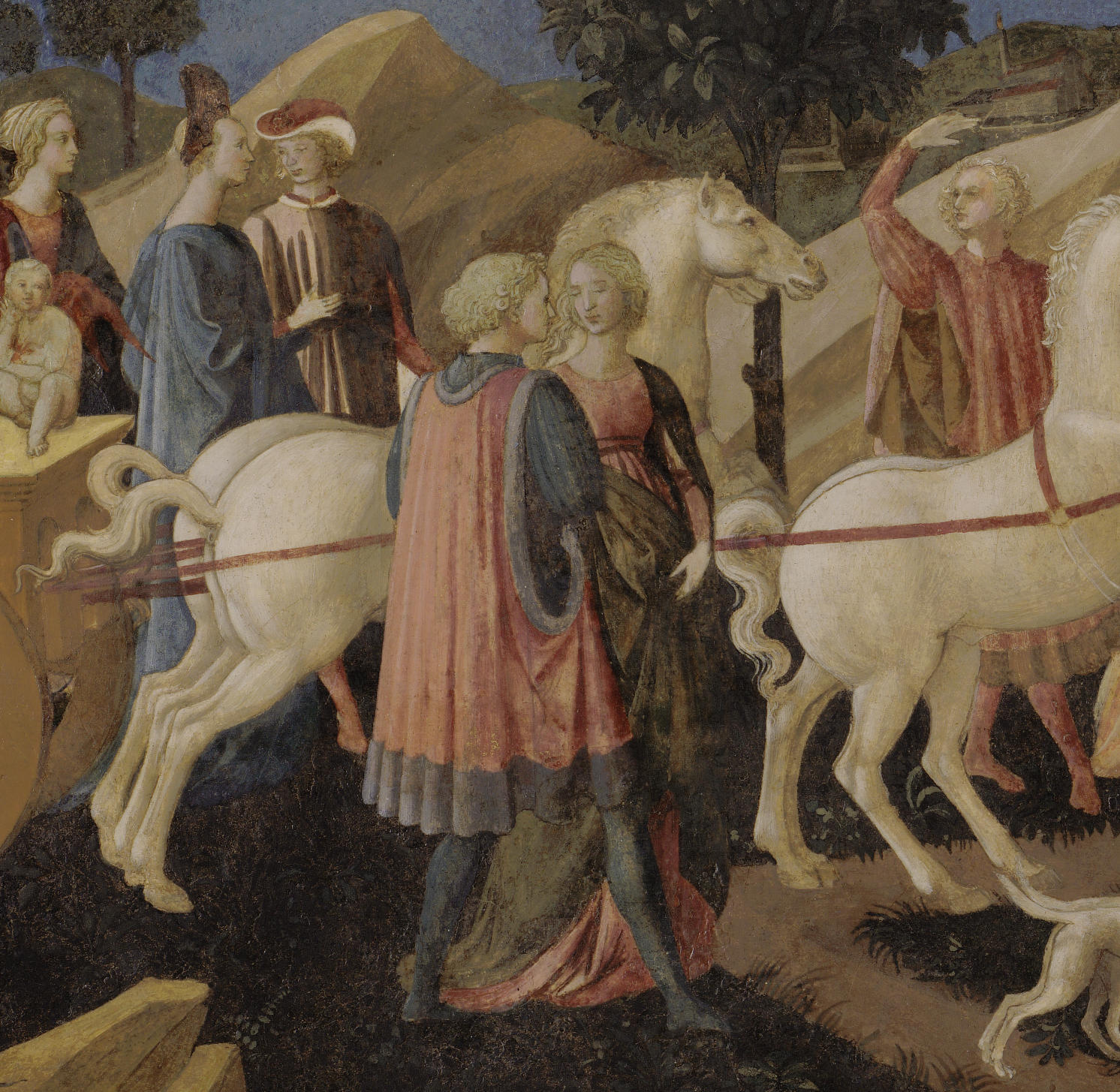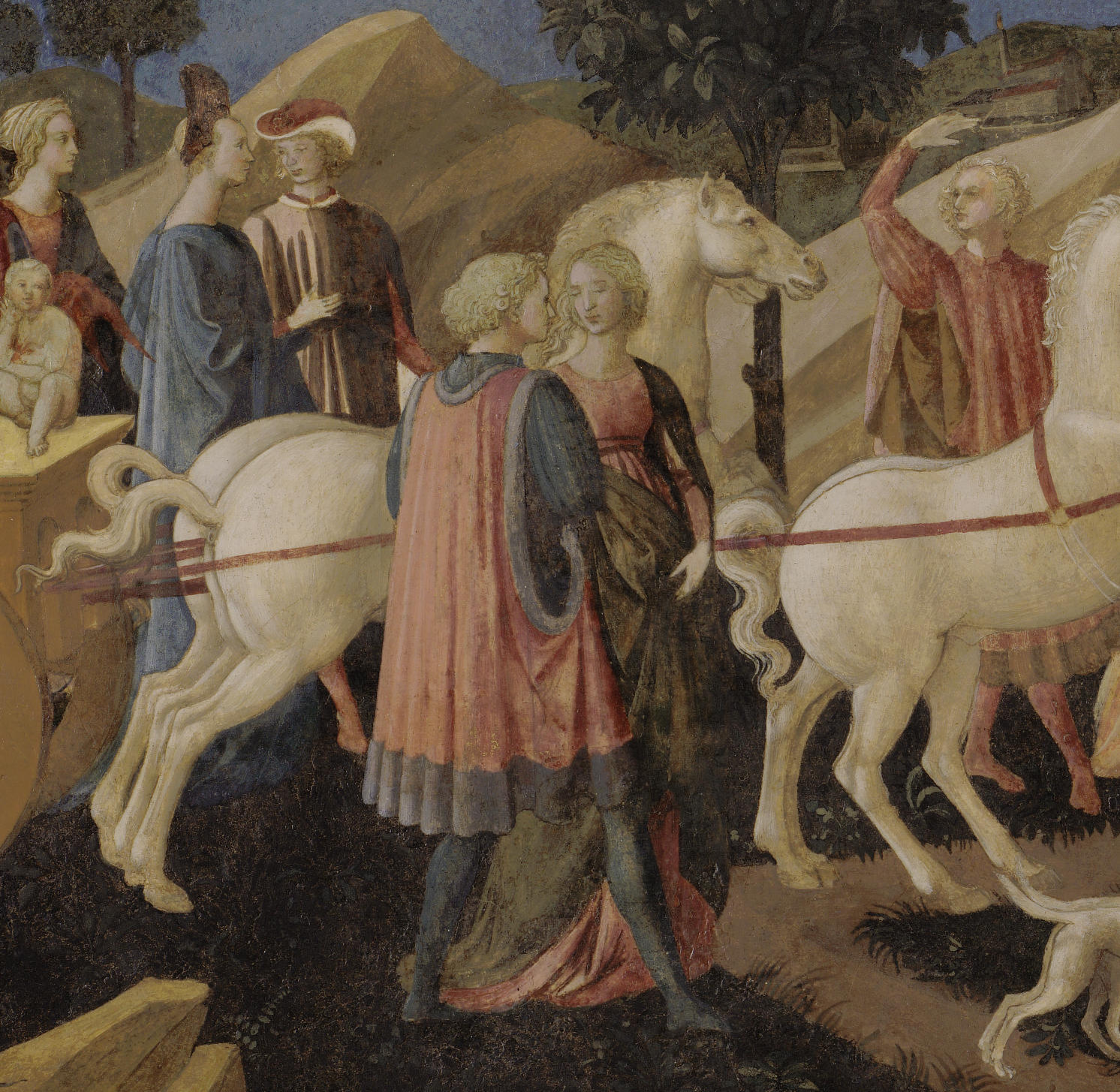In the Florentine artist Francesco Pesellino’s Triumphs of Love, Chastity, and Death displayed in the Gardner Museum’s Early Italian Room, fashionable young women and men with golden locks and shining faces parade alongside two of the three triumphal carts in this cassone panel or marriage chest. These bright young things perfectly embody Italian Renaissance ideals of beauty, and if we focus our gaze only on the sea of fair and radiant faces, it might be difficult to distinguish between the painting’s men and women. Clothing, however, made these distinctions crystal clear.

Isabella Stewart Gardner Museum, Boston (P15e5.1). See it in the Early Italian Room.
Francesco Pesellino (Florence, about 1422–1457), The Triumphs of Love, Chastity and Death, about 1450. Tempera and gold on panel, 45.4 x 157.4 cm (17 7/8 x 61 15/16 in.)
Pesellino’s women wear cascading gowns, with belts high and tight. Their dresses drag along the ground, trailing the wasteful lengths of expensive fabric that preachers condemned in sermons and civic officials legislated against in sumptuary laws. Notably, we can hardly detect any sign of the bodies underneath women’s clothes. The men, on the other hand, show off shapely legs and contours emphasized by their stockings (and here it is good to remember that clothing not only conceals, but can likewise reveal the body).

Isabella Stewart Gardner Museum, Boston (P15e5.1). See it in the Early Italian Room.
Detail of Francesco Pesellino’s Triumphs of Love, Chastity and Death, about 1450, showing a man and a woman
Scanning across the foreground of the panel, we see three pairs of legs prominently represented and displayed from differing angles. Indeed, Italian Renaissance men, and artists, never missed the opportunity to exhibit svelte legs, for they knew that audiences would look at them. Male legs embodied beauty and courtliness. They were praised in poetry and, in life and art, were showcased by the cuts and adornments of hose (calze, in Italian). On the other hand, women’s legs were buried under long, voluminous dresses; women hardly had legs, at least in terms of cultural representation. The tables have turned centuries later. If we were to rewrite ZZ Top for Renaissance Italy: “He’s—not she’s—got legs, he knows how to use them.”
Men’s calze were generally fabricated from wool or wool blends, and sometimes silk, in fifteenth-century Italy. They were attached to upper-body garments by ties pulled tight to create fashionably slender silhouettes. These laces are nowhere visible in Pesellino’s painting, however. They are hidden under lavish outer mantles and tunics, many of which are heavily pleated (and thus tailored from what were considered to be reckless quantities of cloth). These garments are radiantly dyed and constructed from plush textiles, seemingly velvets and other silks.

Isabella Stewart Gardner Museum, Boston. Photo: Sean Dungan
Francesco Pesellino’s Triumphs of Love, Chastity and Death, about 1450, in the Early Italian Room
Many of the entourage’s garments are red (then called crimson), the most expensive color for Renaissance clothing. Madder root or brazilwood dyes furnished most fifteenth-century reds, though the crushed bodies of scale insects known as kermes produced the brightest and most costly crimsons. These little bugs and their secretions were gathered around the Mediterranean, in Eastern Europe, and in a few regions in Asia (and only in the sixteenth century would dyes derived from their cochineal relatives reach Italy from the Americas, providing even more vibrant and colorfast reds). Pesellino’s men and women in splendid crimsons were dressed to impress, though the painting’s most luxurious textile – the only figured silk on display—is the crimson velvet of two heights of pile atop Chastity’s triumphal cart.

Isabella Stewart Gardner Museum, Boston (P15e5.1). See it in the Early Italian Room.
Detail of Francesco Pesellino’s Triumphs of Love, Chastity and Death, about 1450, showing the crimson velvet atop the figure of Chastity's triumphal cart
Renaissance viewers and wearers were also closely attuned to the look—and sometimes the texture and experience—of fur. The most exclusive fur was ermine, which was frequently reserved for nobles in sumptuary laws. We see ermine in Pesellino’s cassone panel not as a pelt, but as the animal itself, adorning Chastity’s banner (the ermine is not actually a distinct animal or species, but rather a stoat in its white, winter coat). Ermines were indeed common symbols of chastity and purity, since, according to animal lore, they would rather give themselves up to a hunter than soil their fur in an attempted escape. Inspecting the banner closely, we can just make out the black dot at the end of the ermine’s tail. This is precisely what Renaissance viewers looked for when they inspected ermine-lined apparel. Set off against the fur’s candid whiteness, each black mark indicated an individual pelt and animal, and thus the clothing’s expense and the wearer’s wealth. Furs typically lined the inside of garments, to keep bodies warm, but tailors displayed furs at hems and margins, or found other ways to turn attire out or around. If you could wear ermine, it was essential to let everyone know. After all, very few folks could afford or were permitted to do so. Pesellino’s fashionistas show off other furs as well. The blond youth standing with his back to us, next to the trailing pair of horses pulling Love’s triumph, flaunts gray vair (vaio) around the sleeve of his crimson tunic and at the garment’s bottom hem. Even these squirrel furs furnished a lush and lavish materiality.
The cassone’s unclothed figures likewise have much to tell us. Pesellino depicts Cupid, the god of love, in three guises: as a bound adolescent in the Triumph of Chastity, and in the Triumph of Love, four times as the familiar infant god of love and once as a strapping, fair-skinned youth, naked, save his blindfold and the strap securing his quiver of arrows. The triumphant Cupid with salmon-colored wings takes aim at love’s next victim, perhaps the man clad in crimson who turns to encourage the party forward with his sweeping gesture.

Isabella Stewart Gardner Museum, Boston (P15e5.1). See it in the Early Italian Room.
Detail of Francesco Pesellino’s Triumphs of Love, Chastity and Death, about 1450, showing Cupid aiming his arrow
There seems to be one additional naked body—the corpse at far right, next to the plodding oxen driving Death’s triumphal chariot (and near a dog or wolf gruesomely gnawing on a human foot). Indeed, in the fifteenth century, most Italians were buried naked or in shrouds. Garments, especially those of precious, brightly colored silks and velvets like we see throughout the painting, were much too expensive to be wasted on a corpse.

Isabella Stewart Gardner Museum, Boston (P15e5.1). See it in the Early Italian Room.
Detail of Francesco Pesellino’s Triumphs of Love, Chastity and Death, about 1450, showing a corpse
Sooner or later, Pesellino reminds us, death triumphs over us all. For most Renaissance men and women, that meant ending their lives as naked as the day they were born.
You May Also Like

Gift at the Gardner
Brilliant Bodies: Fashioning Courtly Men in Early Renaissance Italy

Gift at the Gardner
Triumphs Scarf

Explore the Collection
Francesco Pesellino’s Triumphs of Fame, Time and Eternity, about 1450



